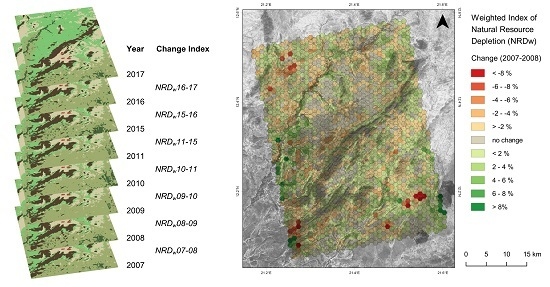A SAR-Based Index for Landscape Changes in African Savannas
Abstract
:1. Introduction
2. Materials and Methods
2.1. Study Area
2.2. Data and Pre-Processing
2.2.1. Satellite Imagery
2.2.2. Pre-Processing and Collection of Samples
2.3. Image Classification
2.4. Index of Landscape Change
2.5. Index of Landscape Variability
3. Results
3.1. Annual Changes
3.1.1. Natural Resources
3.1.2. Natural Resource Depletion
3.2. Overall Change and Variability of Natural Resources
4. Discussion
4.1. Landscape Changes
4.2. Methods
5. Conclusions
Acknowledgments
Author Contributions
Conflicts of Interest
References
- Irons, J.R.; Dwyer, J.L.; Barsi, J.A. The next Landsat satellite: The Landsat data continuity mission. Remote Sens. Environ. 2012, 122, 11–21. [Google Scholar] [CrossRef]
- Wulder, M.A.; White, J.C.; Goward, S.N.; Masek, J.G.; Irons, J.R.; Herold, M.; Cohen, W.B.; Loveland, T.R.; Woodcock, C.E. Landsat continuity: Issues and opportunities for land cover monitoring. Remote Sens. Environ. 2008, 112, 955–969. [Google Scholar] [CrossRef]
- Byrne, G.F.; Crapper, P.F.; Mayo, K.K. Monitoring land-cover change by principal component analysis of multitemporal landsat data. Remote Sens. Environ. 1980, 10, 175–184. [Google Scholar] [CrossRef]
- Fung, T. An Assessment of TM Imagery for Land-cover Change Detection. IEEE Trans. Geosci. Remote Sens. 1990, 28, 681–684. [Google Scholar] [CrossRef]
- Guerschman, J.P.; Paruelo, J.M.; Di Bella, C.; Giallorenzi, M.C.; Pacin, F. Land cover classification in the Argentine Pampas using multi-temporal Landsat TM data. Int. J. Remote Sens. 2003, 24, 3381–3402. [Google Scholar] [CrossRef]
- Yuan, F.; Sawaya, K.E.; Loeffelholz, B.C.; Bauer, M.E. Land cover classification and change analysis of the Twin Cities (Minnesota) Metropolitan Area by multitemporal Landsat remote sensing. Remote Sens. Environ. 2005, 98, 317–328. [Google Scholar] [CrossRef]
- Bakr, N.; Weindorf, D.C.; Bahnassy, M.H.; Marei, S.M.; El-Badawi, M.M. Monitoring land cover changes in a newly reclaimed area of Egypt using multi-temporal Landsat data. Appl. Geogr. 2010, 30, 592–605. [Google Scholar] [CrossRef]
- Zhu, Z.; Woodcock, C.E.; Holden, C.; Yang, Z. Generating synthetic Landsat images based on all available Landsat data: Predicting Landsat surface reflectance at any given time. Remote Sens. Environ. 2015, 162, 67–83. [Google Scholar] [CrossRef]
- Masek, J.G.; Huang, C.; Wolfe, R.; Cohen, W.; Hall, F.; Kutler, J.; Nelson, P. North American forest disturbance mapped from a decadal Landsat record. Remote Sens. Environ. 2008, 112, 2914–2926. [Google Scholar] [CrossRef]
- He, L.; Chen, J.M.; Zhang, S.; Gomez, G.; Pan, Y.; McCullough, K.; Birdsey, R.; Masek, J.G. Normalized algorithm for mapping and dating forest disturbances and regrowth for the United States. Int. J. Appl. Earth Obs. Geoinf. 2011, 13, 236–245. [Google Scholar] [CrossRef]
- Song, C.; Woodcock, C.E.; Seto, K.C.; Lenney, M.P.; Macomber, S.A. Classification and change detection using Landsat TM data: When and how to correct atmospheric effects? Remote Sens. Environ. 2001, 75, 230–244. [Google Scholar] [CrossRef]
- Warren, S.G.; Hahn, C.J.; London, J.; Chervin, R.; Jenne, R.L. Global Distribution of Total Cloud Cover and Cloud Type Amounts over Land. NCAR Tech. Note TN-273+STR. Available online: http://opensky.ucar.edu/islandora/object/technotes%3A444/datastream/PDF/download/citation.pdf (accessed on 22 November 2016).
- Gu, G.; Zhang, C. Cloud components of the Intertropical Convergence Zone. J. Geophys. Res. 2002, 107. [Google Scholar] [CrossRef]
- Kummerow, C.; Barnes, W.; Kozu, T.; Shiue, J.; Simpson, J. The Tropical rainfall measuring mission (TRMM) sensor package. J. Atmos. Ocean. Technol. 1998, 15, 809–817. [Google Scholar] [CrossRef]
- Kummerow, C.; Simpson, J.; Thiele, O.; Barnes, W.; Chang, A.T.C.; Stocker, E.; Adler, R.F.; Hou, A.; Kakar, R.; Wentz, F.; et al. The status of the tropical rainfall measuring mission (TRMM) after two years in orbit. J. Appl. Meteorol. 2000, 39, 1965–1982. [Google Scholar] [CrossRef]
- Asner, G.P. Cloud cover in Landsat observations of the Brazilian Amazon. Int. J. Remote Sens. 2001, 22, 3855–3862. [Google Scholar] [CrossRef]
- Mas, J.-F. Monitoring land-cover changes: A comparison of change detection techniques. Int. J. Remote Sens. 1999, 20, 139–152. [Google Scholar] [CrossRef]
- Ju, J.; Roy, D.P. The availability of cloud-free Landsat ETM+ data over the conterminous United States and globally. Remote Sens. Environ. 2008, 112, 1196–1211. [Google Scholar] [CrossRef]
- Fletcher, K. ERS Missions. 20 Years of Observing Earth; ESA Communications: Noordwijk, The Netherlands, 2013. [Google Scholar]
- Flett, D.; Crevier, Y.; Girard, R. The RADARSAT Constellation Mission: Meeting the government of Canada’S needs and requirements. In Proceedings of the 2009 IEEE International Geoscience and Remote Sensing Symposium, Cape Town, South Africa, 12–17 July 2009. [Google Scholar]
- Torres, R.; Snoeij, P.; Geudtner, D.; Bibby, D.; Davidson, M.; Attema, E.; Potin, P.; Rommen, B.; Floury, N.; Brown, M.; et al. GMES Sentinel-1 mission. Remote Sens. Environ. 2012, 120, 9–24. [Google Scholar] [CrossRef]
- Liew, S.C.; Kam, S.P.; Tuong, T.P.; Chen, P.; Minh, V.Q.; Lim, H. Landcover classification over the Mekong river delta using ERS and RADARSAT SAR images. In Proceedings of the 1997 IEEE International Geoscience and Remote Sensing Symposium, Remote Sensing—A Scientific Vision for Sustainable Development, Singapore, 3–8 August 1997. [Google Scholar]
- Braun, A.; Lang, S.; Hochschild, V. Impact of refugee camps on their environment a case study using multi-temporal SAR data. J. Geogr. Environ. Earth Sci. Int. 2016, 4, 1–17. [Google Scholar] [CrossRef]
- McAvoy, J.G.; Krakowskii, E.M. A Knowledge based system for the interpretation of SAR Images of sea ice. In Proceedings of the 12th Canadian Symposium on Remote Sensing Geoscience and Remote Sensing Symposium, Vancouver, BC, Canada, 10–14 July 1989. [Google Scholar]
- Pierce, L.E.; Ulaby, F.T.; Sarabandi, K.; Dobson, M.C. Knowledge-based classification of polarimetric SAR images. IEEE Trans. Geosci. Remote Sens. 1994, 32, 1081–1086. [Google Scholar] [CrossRef]
- Dobson, M.C.; Pierce, L.E.; Ulaby, F.T. Knowledge-based land-cover classification using ERS-1/JERS-1 SAR composites. IEEE Trans. Geosci. Remote Sens. 1996, 34, 83–99. [Google Scholar] [CrossRef]
- Nunnally, N.R. Integrated landscape analysis with radar imagery. Remote Sens. Environ. 1969, 1, 1–6. [Google Scholar] [CrossRef]
- Askne, J.; Hagberg, J.O. Potential of interferometric SAR for classification of land surfaces. In Proceedings of the IEEE International Geoscience and Remote Sensing Symposium, Tokyo, Japan, 18–21 August 1993. [Google Scholar]
- Dutra, L.V. Feature extraction and selection for ERS-1/2 InSAR classification. Int. J. Remote Sens. 1999, 20, 993–1016. [Google Scholar] [CrossRef]
- Engdahl, M.E.; Hyyppa, J.M. Land-cover classification using multitemporal ERS-1/2 insar data. IEEE Trans. Geosci. Remote Sens. 2003, 41, 1620–1628. [Google Scholar] [CrossRef]
- Huber, R.; Dutra, L.V. Feature selection for ERS-1/2 InSAR classification: High dimensionality case. In Proceedings of the 1998 IEEE International Geoscience and Remote Sensing, Seattle, WA, USA, 6–10 July 1998. [Google Scholar]
- Oliver, C.J. Rain forest classification based on SAR texture. IEEE Trans. Geosci. Remote Sens. 2000, 38, 1095–1104. [Google Scholar] [CrossRef]
- Bruzzone, L.; Marconcini, M.; Wegmuller, U.; Wiesmann, A. An advanced system for the automatic classification of multitemporal SAR images. IEEE Trans. Geosci. Remote Sens. 2004, 42, 1321–1334. [Google Scholar] [CrossRef]
- Van Zyl, J.J.; Burnette, C.F. Bayesian classification of polarimetric SAR images using adaptive a priori probabilities. Int. J. Remote Sens. 1992, 13, 835–840. [Google Scholar] [CrossRef]
- Rignot, E.; Williams, C.L.; Way, J.; Viereck, L.A. Mapping of forest types in Alaskan boreal forests using SAR imagery. IEEE Trans. Geosci. Remote Sens. 1994, 32, 1051–1059. [Google Scholar] [CrossRef]
- Chiang, H.-C.; Moses, R.L.; Potter, L.C. Model-based classification of radar images. IEEE Trans. Inf. Theory 2000, 46, 1842–1854. [Google Scholar] [CrossRef]
- Tzeng, Y.C.; Chen, K.S. A fuzzy neural network to SAR image classification. IEEE Trans. Geosci. Remote Sens. 1998, 36, 301–307. [Google Scholar] [CrossRef]
- Chen, C.-T.; Chen, K.-S.; Lee, J.-S. The use of fully polarimetric information for the fuzzy neural classification of SAR images. IEEE Trans. Geosci. Remote Sens. 2003, 41, 2089–2100. [Google Scholar] [CrossRef]
- Zhang, Y.; Wu, L.; Neggaz, N.; Wang, S.; Wei, G. Remote-sensing image classification based on an improved probabilistic neural network. Sensors 2009, 9, 7516–7539. [Google Scholar] [CrossRef] [PubMed]
- Van Beijma, S.; Comber, A.; Lamb, A. Random forest classification of salt marsh vegetation habitats using quad-polarimetric airborne SAR, elevation and optical RS data. Remote Sens. Environ. 2014, 149, 118–129. [Google Scholar] [CrossRef]
- Du, P.; Samat, A.; Waske, B.; Liu, S.; Li, Z. Random forest and rotation forest for fully polarized SAR image classification using polarimetric and spatial features. ISPRS J. Photogramm. Remote Sens. 2015, 105, 38–53. [Google Scholar] [CrossRef]
- Gupta, S.; Singh, D.; Singh, K.P.; Kumar, S. An efficient use of random forest technique for SAR data classification. In Proceedings of the 2015 IEEE International Geoscience and Remote Sensing Symposium, Milan, Italy, 26–31 July 2015. [Google Scholar]
- Lee, J.-S.; Grunes, M.R.; Kwok, R. Classification of multi-look polarimetric SAR imagery based on complex Wishart distribution. Int. J. Remote Sens. 1994, 15, 2299–2311. [Google Scholar] [CrossRef]
- Cloude, S.R.; Pottier, E. An entropy based classification scheme for land applications of polarimetric SAR. IEEE Trans. Geosci. Remote Sens. 1997, 35, 68–78. [Google Scholar] [CrossRef]
- Alberga, V. A study of land cover classification using polarimetric SAR parameters. Int. J. Remote Sens. 2007, 28, 3851–3870. [Google Scholar] [CrossRef]
- Qi, Z.; Yeh, A.G.-O.; Li, X.; Lin, Z. A novel algorithm for land use and land cover classification using RADARSAT-2 polarimetric SAR data. Remote Sens. Environ. 2012, 118, 21–39. [Google Scholar] [CrossRef]
- White, R.G. Change detection in SAR imagery. Int. J. Remote Sens. 1991, 12, 339–360. [Google Scholar] [CrossRef]
- Rignot, E.; van Zyl, J.J. Change detection techniques for ERS-1 SAR data. IEEE Trans. Geosci. Remote Sens. 1993, 31, 896–906. [Google Scholar] [CrossRef]
- Bazi, Y.; Bruzzone, L.; Melgani, F. An unsupervised approach based on the generalized Gaussian model to automatic change detection in multitemporal SAR images. IEEE Trans. Geosci. Remote Sens. 2005, 43, 874–887. [Google Scholar] [CrossRef]
- Dekker, R.J. Speckle filtering in satellite SAR change detection imagery. Int. J. Remote Sens. 1998, 19, 1133–1146. [Google Scholar] [CrossRef]
- Bovenga, F.; Refice, A.; Nutricato, R.; Pasquariello, G.; de Carolis, G. Automated calibration of multi-temporal ERS SAR data. In Proceedings of the IEEE International Geoscience and Remote Sensing Symposium, Toronto, ON, Canada, 24–28 June 2002. [Google Scholar]
- Townsend, P.A.; Foster, J.R. A synthetic aperture radar-based model to assess historical changes in lowland floodplain hydroperiod. Water Resour. Res. 2002, 38, 20-1–20-10. [Google Scholar] [CrossRef]
- Beisl, C.H.; de Miranda, F.P.; Evsukoff, A.G.; Pedroso, E.C. Assessment of environmental sensitivity index of flooding areas in western Amazonia using fuzzy logic in the dual season GRFM JERS-1 SAR image mosaics. In Proceedings of the 2003 IEEE International Geoscience and Remote Sensing Symposium, Toulouse, France, 21–25 July 2003. [Google Scholar]
- Hoffmann, A.A.; Siegert, F.; Hinrichs, A. Fire Damage in East Kalimantan in 1997/98 Related to Land Use and Vegetation Classes. Satellite Radar Inventory Results and Proposals for Further Actions; IFFM/SFMP: Samarinda, Indonesia, 1987. [Google Scholar]
- Saatchi, S.S.; Soares, J.V.; Alves, D.S. Mapping deforestation and land use in amazon rainforest by using SIR-C imagery. Remote Sens. Environ. 1997, 59, 191–202. [Google Scholar] [CrossRef]
- Strozzi, T.; Wegmuller, U.; Luckman, A.; Balzter, H. Mapping deforestation in Amazon with ERS SAR interferometry. In Proceedings of the IEEE 1999 International Geoscience and Remote Sensing Symposium, Hamburg, Germany, 28 June–2 July 1999. [Google Scholar]
- Almeida-Filho, R.; Rosenqvist, A.; Shimabukuro, Y.E.; Dos Santos, J.R. Evaluation and perspectives of using multitemporal L-Band SAR data to monitor deforestation in the Brazilian Amazonia. IEEE Geosci. Remote Sens. Lett. 2005, 2, 409–412. [Google Scholar] [CrossRef]
- Almeida-Filho, R.; Shimabukuro, Y.E.; Rosenqvist, A.; Sánchez, G.A. Using dual-polarized ALOS PALSAR data for detecting new fronts of deforestation in the Brazilian Amazônia. Int. J. Remote Sens. 2009, 30, 3735–3743. [Google Scholar] [CrossRef]
- Ryan, C.M.; Hill, T.; Woollen, E.; Ghee, C.; Mitchard, E.; Cassells, G.; Grace, J.; Woodhouse, I.H.; Williams, M. Quantifying small-scale deforestation and forest degradation in African woodlands using radar imagery. Glob. Chang. Biol. 2012, 18, 243–257. [Google Scholar] [CrossRef]
- Mitchard, E.T.A.; Saatchi, S.S.; Woodhouse, I.H.; Nangendo, G.; Ribeiro, N.S.; Williams, M.; Ryan, C.M.; Lewis, S.L.; Feldpausch, T.R.; Meir, P. Using satellite radar backscatter to predict above-ground woody biomass: A consistent relationship across four different African landscapes. Geophys. Res. Lett. 2009. [Google Scholar] [CrossRef]
- Mitchard, E.; Saatchi, S.S.; Lewis, S.L.; Feldpausch, T.R.; Woodhouse, I.H.; Sonké, B.; Rowland, C.; Meir, P. Measuring biomass changes due to woody encroachment and deforestation/degradation in a forest–savanna boundary region of central Africa using multi-temporal L-band radar backscatter. Remote Sens. Environ. 2011, 115, 2861–2873. [Google Scholar] [CrossRef]
- Shen, G.; Liao, J.; Zhang, L.; Li, X. Wetland landscape analysis using polarimetric RADARSAT-2 data. In Proceedings of the 2014 IEEE International Geoscience and Remote Sensing Symposium, Quebec City, QC, Canada, 13–18 July 2014. [Google Scholar]
- Tewkesbury, A.P.; Comber, A.J.; Tate, N.J.; Lamb, A.; Fisher, P.F. A critical synthesis of remotely sensed optical image change detection techniques. Remote Sens. Environ. 2015, 160, 1–14. [Google Scholar] [CrossRef]
- Hussain, M.; Chen, D.; Cheng, A.; Wei, H.; Stanley, D. Change detection from remotely sensed images: From pixel-based to object-based approaches. ISPRS J. Photogramm. Remote Sens. 2013, 80, 91–106. [Google Scholar] [CrossRef]
- Walker, P.A.; Peters, P.E. Making Sense in Time: Remote Sensing and the Challenges of Temporal Heterogeneity in Social Analysis of Environmental Change. Hum. Ecol. 2007, 35, 69–80. [Google Scholar] [CrossRef]
- Hauck, J.; Görg, C.; Varjopuro, R.; Ratamäki, O.; Maes, J.; Wittmer, H.; Jax, K. “Maps have an air of authority”: Potential benefits and challenges of ecosystem service maps at different levels of decision making. Ecosyst. Serv. 2013, 4, 25–32. [Google Scholar] [CrossRef]
- Kienberger, S.; Füreder, P.; Hölbling, D.; Tiede, D.; Contreras Mojica, D.M.; Hagenlocher, M.; Zeil, P.; Lang, S. Von Geodaten zu nutzbarer Geoinformation: Entwicklung von und Anforderung an kartografische Produkte im Katastrophenmanagement-Zyklus. In Proceedings of the Workshop “Raum Zeit Risiko”, München, Germany, 28 November 2013. [Google Scholar]
- Ariti, A.T.; van Vliet, J.; Verburg, P.H. Land-use and land-cover changes in the Central Rift Valley of Ethiopia: Assessment of perception and adaptation of stakeholders. Appl. Geogr. 2015, 65, 28–37. [Google Scholar] [CrossRef]
- Hansen, K.F. Chad. In Africa Yearbook Volume 11; Elischer, S., Mehler, A., Hofmeier, R., Melber, H., Eds.; Brill: Leiden, The Netherlands, 2015; pp. 201–208. [Google Scholar]
- Rishmawi, K.; Prince, S. Environmental and anthropogenic degradation of vegetation in the Sahel from 1982 to 2006. Remote Sens. 2016. [Google Scholar] [CrossRef]
- Southworth, J.; Zhu, L.; Bunting, E.; Ryan, S.J.; Herrero, H.; Waylen, P.R.; Hill, M.J. Changes in vegetation persistence across global savanna landscapes, 1982–2010. J. Land Use Sci. 2014, 11, 7–32. [Google Scholar] [CrossRef]
- Office for the Coordination of Humanitarian Affairs (OCHA). Profil Régional du Sila: Novembre 2012. Available online: https://docs.unocha.org/sites/dms/CHAD/Profil_Dar%20Sila_Novembre%202012.pdf (accessed on 8 December 2016).
- Clark, J.; Tan, V. Hundreds Flee New Fighting in Darfur; UNHCR Opens 8th Camp in Chad. Available online: http://www.unhcr.org/print/40c081119.html (accessed on 15 November 2016).
- Bouchardy, J.-Y. Radar Images and Geographic Information Helping Identify Water Resources during Humanitarian Crisis: The Case of Chad/Sudan (Darfur) Emergency. In Global Monitoring for Sustainability and Security, Proceedings of the 31st International Symposium of Remote Sensing & the Environment, St. Petersburg, Russian, 20–24 June 2005; Bobylev, L.P., Ed.; International Center for Remote Sensing of Environment: Berlin, Germany, 2005. [Google Scholar]
- Humanitarian Information Unit. Sudan (Darfur) and Chad Border Region: Confirmed Damaged and Destroyed Villages. Available online: http://reliefweb.int/map/sudan/sudan-darfur-and-chad-border-region-confirmed-damaged-and-destroyed-villages-2-august-2004 (accessed on 14 November 2016).
- Middleton, N.; Thomas, D.S.G. World Atlas of Desertification, 2nd ed.; Arnold: London, UK, 1997. [Google Scholar]
- Harris, I.; Jones, P.D.; Osborn, T.J.; Lister, D.H. Updated high-resolution grids of monthly climatic observations—The CRU TS3.10 Dataset. Int. J. Climatol. 2014, 34, 623–642. [Google Scholar] [CrossRef]
- Funk, C.; Rowland, J.; Eilerts, G.; Adoum, A.; White, L. A Climate Trend Analysis of Chad: Famine Early Warning Systems Network—Informaing Climate Change Adaption Series; FEWSNET/US Geological Survey Fact Sheet 2012–3070; U.S. Geological Survey: Reston, VA, USA, 2012.
- Brownfield, M.E. Assessment of undiscovered oil and gas resources of the sud province, Central East Africa. In Geologic Assessment of Undiscovered Hydrocarbon Resources of Sub-Saharan Africa; Brownfield, M.E., Ed.; U.S. Geological Survey: Reston, VA, USA, 2011. [Google Scholar]
- Pias, J. Les formations tertiaires et quaternaires de la cuvette tchadienne (République du Tchad). In Congrès Panafricain de Préhistoire et de L’étude du Quaternaire; Dakar: Bondy, France, 1976; pp. 425–429. [Google Scholar]
- White, F. Vegetation Map of Africa. A Descriptive Memoir to Accompany the Unesco/AETFAT/UNSO Vegetation Map of Africa; Unesco: Paris, France, 1981. [Google Scholar]
- Wickens, G.E. The Flora of Jebel Marra (Sudan Republic) and Its Geographical Affinities; H.M. Stationery Off.: London, UK, 1976. [Google Scholar]
- Ministerie van Defensie. European Union Force Chad/CAR. Available online: https://www.defensie.nl/binaries/defence/documents/leaflets/2013/02/05/european-union-force-chad-car-pdf/european-union-force-chad-car-pdf.pdf (accessed on 8 December 2016).
- Markham, B.L.; Storey, J.C.; Williams, D.L.; Irons, J.R. Landsat sensor performance: History and current status. IEEE Trans. Geosci. Remote Sens. 2004, 42, 2691–2694. [Google Scholar] [CrossRef]
- JAXA. ALOS/PALSAR Level 1.1/1.5 Product Format Description. NEB-070062B. Available online: http://www.eorc.jaxa.jp/ALOS/en/doc/fdata/PALSAR_x_Format_EL.pdf (accessed on 5 April 2017).
- JAXA. ALOS-2/PALSAR-2 Level 1.1/1.5 Product Format Description. Ü129-132. Available online: http://www.eorc.jaxa.jp/ALOS-2/en/doc/fdata/PALSAR-2_xx_Format_CEOS_E_r.pdf (accessed on 5 April 2017).
- Shimada, M.; Isoguchi, O.; Tadono, T.; Isono, K. PALSAR Radiometric and Geometric Calibration. IEEE Trans. Geosci. Remote Sens. 2009, 47, 3915–3932. [Google Scholar] [CrossRef]
- Small, D. Flattening Gamma: Radiometric Terrain Correction for SAR Imagery. IEEE Trans. Geosci. Remote Sens. 2011, 49, 3081–3093. [Google Scholar] [CrossRef]
- Loew, A.; Mauser, W. Generation of geometrically and radiometrically terrain corrected SAR image products. Remote Sens. Environ. 2007, 106, 337–349. [Google Scholar] [CrossRef]
- Collins, M.J.; Wiebe, J.; Clausi, D.A. The effect of speckle filtering on scale-dependent texture estimation of a forested scene. IEEE Trans. Geosci. Remote Sens. 2000, 38, 1160–1170. [Google Scholar] [CrossRef]
- Prasad, T.S.; Gupta, R.K. Texture based classification of multidate SAR images—A case study. Geocarto Int. 1998, 13, 53–62. [Google Scholar] [CrossRef]
- Haralick, R.M.; Shanmugam, K.; Dinstein, I. Textural Features for Image Classification. IEEE Trans. Syst. Man Cybern. 1973, 3, 610–621. [Google Scholar] [CrossRef]
- Chander, G.; Markham, B.L.; Helder, D.L. Summary of current radiometric calibration coefficients for Landsat MSS, TM, ETM+, and EO-1 ALI sensors. Remote Sens. Environ. 2009, 113, 893–903. [Google Scholar] [CrossRef]
- Moran, M.; Jackson, R.D.; Slater, P.N.; Teillet, P.M. Evaluation of simplified procedures for retrieval of land surface reflectance factors from satellite sensor output. Remote Sens. Environ. 1992, 41, 169–184. [Google Scholar] [CrossRef]
- Forkuor, G.; Landmann, T.; Conrad, C.; Dech, S. Agricultural land use mapping in the sudanian savanna of West Africa: Current status and future possibilities. In Proceedings of the 2012 IEEE International Geoscience and Remote Sensing Symposium, Munich, Germany, 22–27 July 2012. [Google Scholar]
- Guiguindibaye, M.; Belem, M.O.; Boussim, J.L.; Ndoutorlengar, M. Effect of early fires on the behavior of some perennial woody and herbaceous species in Sudan savanna in chad. Indian J. Sci. Res. Technol. 2015, 3, 56–65. [Google Scholar]
- López-García, M.J.; Caselles, V. Mapping burns and natural reforestation using thematic Mapper data. Geocarto Int. 1991, 6, 31–37. [Google Scholar] [CrossRef]
- Drury, S.A. Image Interpretation in Geology, 3rd ed.; Blackwell Science: Malden, MA, USA, 2001. [Google Scholar]
- Liu, J.; Heiskanen, J.; Aynekulu, E.; Maeda, E.; Pellikka, P. Land Cover Characterization in West Sudanian Savannas Using Seasonal Features from Annual Landsat Time Series. Remote Sens. 2016. [Google Scholar] [CrossRef]
- Hartigan, J.A.; Wong, M.A. Algorithm AS 136: A K-Means Clustering Algorithm. Appl. Stat. 1979, 28, 100. [Google Scholar] [CrossRef]
- Fisher, R.A. On an Absolute Criterion for Fitting Frequency Curves. Stat. Sci. 1912, 12, 39–41. [Google Scholar]
- Breiman, L. Random Forests. Mach. Learn. 2001, 45, 5–32. [Google Scholar] [CrossRef]
- Breiman, L.; Friedman, J.H.; Olshen, R.A.; Stone, C.J. Classification and Regression Trees; Belmont: Wadsworth, OH, USA, 1984. [Google Scholar]
- Hagenlocher, M.; Lang, S.; Tiede, D. Integrated assessment of the environmental impact of an IDP camp in Sudan based on very high resolution multi-temporal satellite imagery. Remote Sens. Environ. 2012, 126, 27–38. [Google Scholar] [CrossRef]
- Birch, C.P.; Oom, S.P.; Beecham, J.A. Rectangular and hexagonal grids used for observation, experiment and simulation in ecology. Ecol. Model. 2007, 206, 347–359. [Google Scholar] [CrossRef]
- Pickett, S.; Cadenasso, M.L.; Benning, T.L. Biotic and abiotic variability as key determinants of savanna heterogeneity at multiple spatiotemporal scales. In The Kruger Experience: Ecology and Management of Savanna Heterogeneity; Biggs, H., du Toit, J.T., Walker, B.H., Rogers, K.H., Sinclair, A.R.E., Eds.; Island Press: Washington, DC, USA, 2003. [Google Scholar]
- Hobbs, R.J. Remote sensing of spatial and temporal dynamics of vegetation. In Remote Sensing of Biosphere Functioning; Hobbs, R.J., Mooney, H.A., Eds.; Springer: New York, NY, USA, 1990; pp. 203–219. [Google Scholar]
- Haack, B.N.; Solomon, E.K.; Bechdol, M.A.; Herold, N.D. Radar and optical data comparison/integration for urban delineation: A case study. Photogramm. Eng. Remote Sens. 2002, 68, 1289–1296. [Google Scholar]
- Le Toan, T.; Mermoz, S.; Fichet, L.V.; Sannier, C.; Bouvet, A. Comparison of optical and SAR data for forest cover mapping. In Proceedings of the 2014 IEEE International Geoscience & Remote Sensing Symposium, Québec City, QC, Canada, 13–18 July 2014; IEEE: Piscataway, NJ, USA, 2014. [Google Scholar]
- Hyyppä, J.; Hyyppä, H.; Inkinen, M.; Engdahl, M.; Linko, S.; Zhu, Y.-H. Accuracy comparison of various remote sensing data sources in the retrieval of forest stand attributes. For. Ecol. Manag. 2000, 128, 109–120. [Google Scholar] [CrossRef]
- Malila, W.A. Change Vector Analysis: An Approach for Detecting Forest Changes with Landsat. LARS Symposia. Available online: http://docs.lib.purdue.edu/lars_symp (accessed on 16 December 2016).
- Serra, P.; Pons, X.; Saurí, D. Post-classification change detection with data from different sensors: Some accuracy considerations. Int. J. Remote Sens. 2003, 24, 3311–3340. [Google Scholar] [CrossRef]
- UNHCR. Sudan/Chad Update: Highlights. Update 15. Available online: http://www.unhcr.org/430f47762.pdf (accessed on 31 January 2017).
- Farman-Farmaian, M.; Ndakass, V. UNHCR Chad at a Glance. Available online: http://reliefweb.int/sites/reliefweb.int/files/resources/UNHCR%20Chad%20at%20a%20Glance-30April2014.pdf (accessed on 31 January 2017).
- Monier, C. Goz Beïda: Monthly Report. Available online: https://www.unicef.org/wcaro/wcaro_chad-UNICEFMonthly_Report_Nov_09.pdf (accessed on 31 January 2017).
- Hirota, M.; Holmgren, M.; van Nes, E.H.; Scheffer, M. Global resilience of tropical forest and savanna to critical transitions. Science (New York) 2011, 334, 232–235. [Google Scholar] [CrossRef] [PubMed]
- Mitchell, T.D.; Carter, T.R.; Jones, P.D.; Hulme, M.; New, M. A Comprehensive Set of High-Resolution Grids of Monthly Climate for Europe and the Globe: The Observed Record (1901–2000) and 16 Scenarios (2001–2100); Tyndall Centre for Climate Change Research Working Paper; Tyndall Centre for Climate Change Research: Norwich, UK, 2004. [Google Scholar]
- Heumann, B.W.; Seaquist, J.W.; Eklundh, L.; Jönsson, P. AVHRR derived phenological change in the Sahel and Soudan, Africa, 1982–2005. Remote Sens. Environ. 2007, 108, 385–392. [Google Scholar] [CrossRef]
- Lee, R.; Yu, F.; Price, K.P.; Ellis, J.; Shi, P. Evaluating vegetation phenological patterns in Inner Mongolia using NDVI time-series analysis. Int. J. Remote Sens. 2002, 23, 2505–2512. [Google Scholar] [CrossRef]
- Wagenseil, H.; Samimi, C. Assessing spatio—Temporal variations in plant phenology using Fourier analysis on NDVI time series: Results from a dry savannah environment in Namibia. Int. J. Remote Sens. 2006, 27, 3455–3471. [Google Scholar] [CrossRef]
- Murthy, C.S.; Raju, P.V.; Badrinath, K.V.S. Classification of wheat crop with multi-temporal images: Performance of maximum likelihood and artificial neural networks. Int. J. Remote Sens. 2003, 24, 4871–4890. [Google Scholar] [CrossRef]
- Shao, Y.; Lunetta, R.S. Comparison of support vector machine, neural network, and CART algorithms for the land-cover classification using limited training data points. ISPRS J. Photogramm. Remote Sens. 2012, 70, 78–87. [Google Scholar] [CrossRef]
- Laczko, F.; Aghazarm, C. Migration, Environment and the Climate Change. Assessng the Evidence; International Organization for Migration: Geneva, Switzerland, 2009. [Google Scholar]
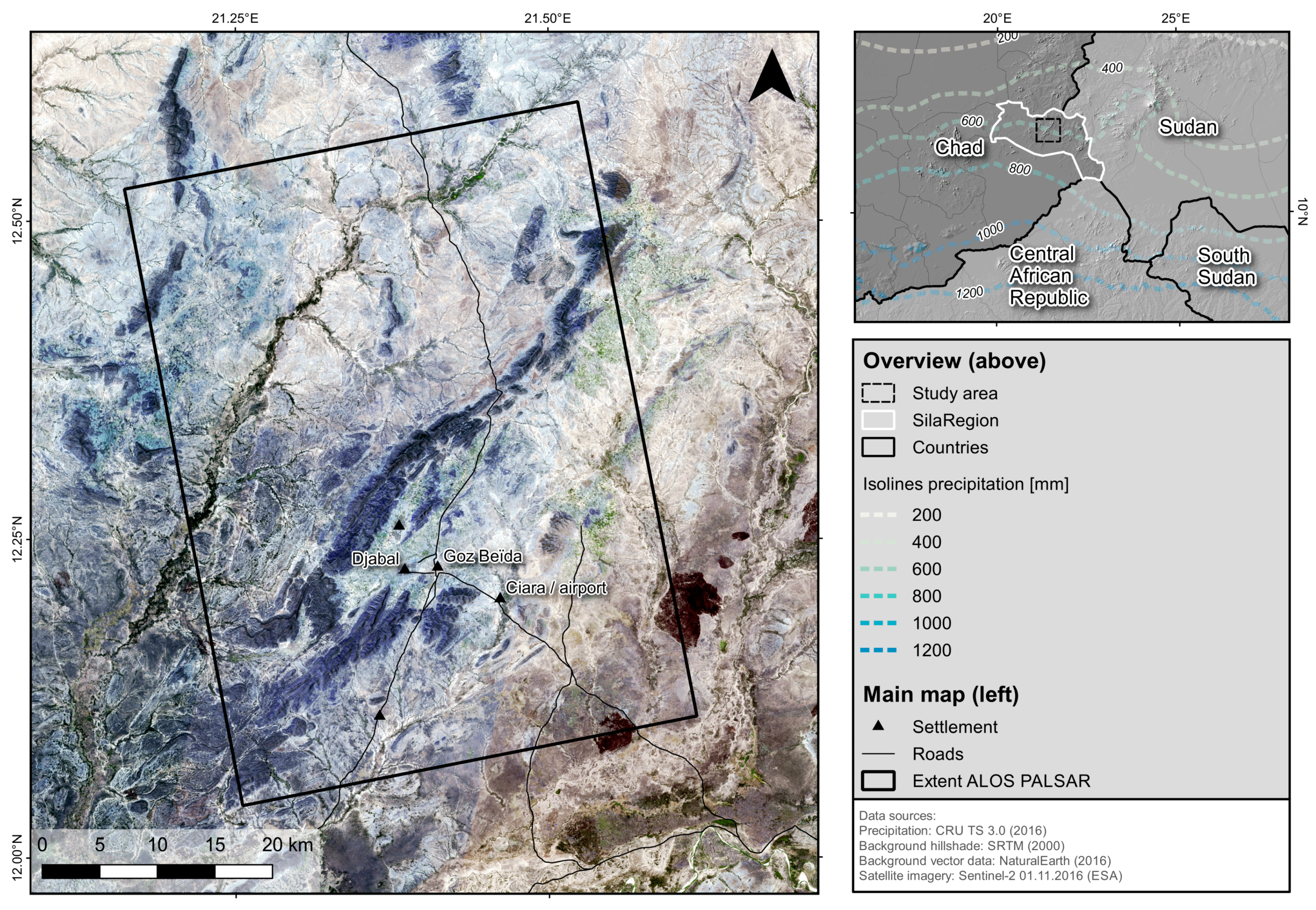
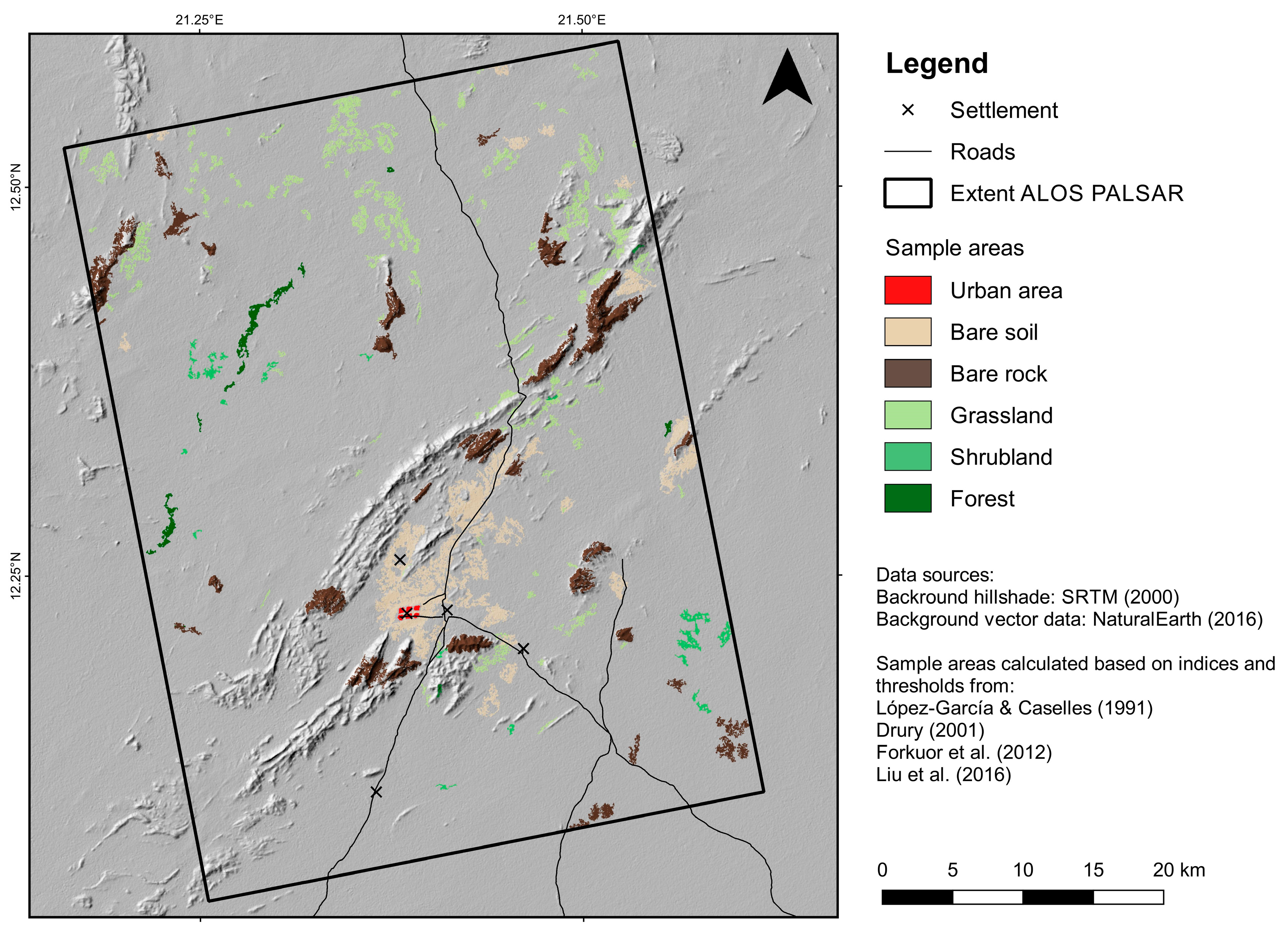

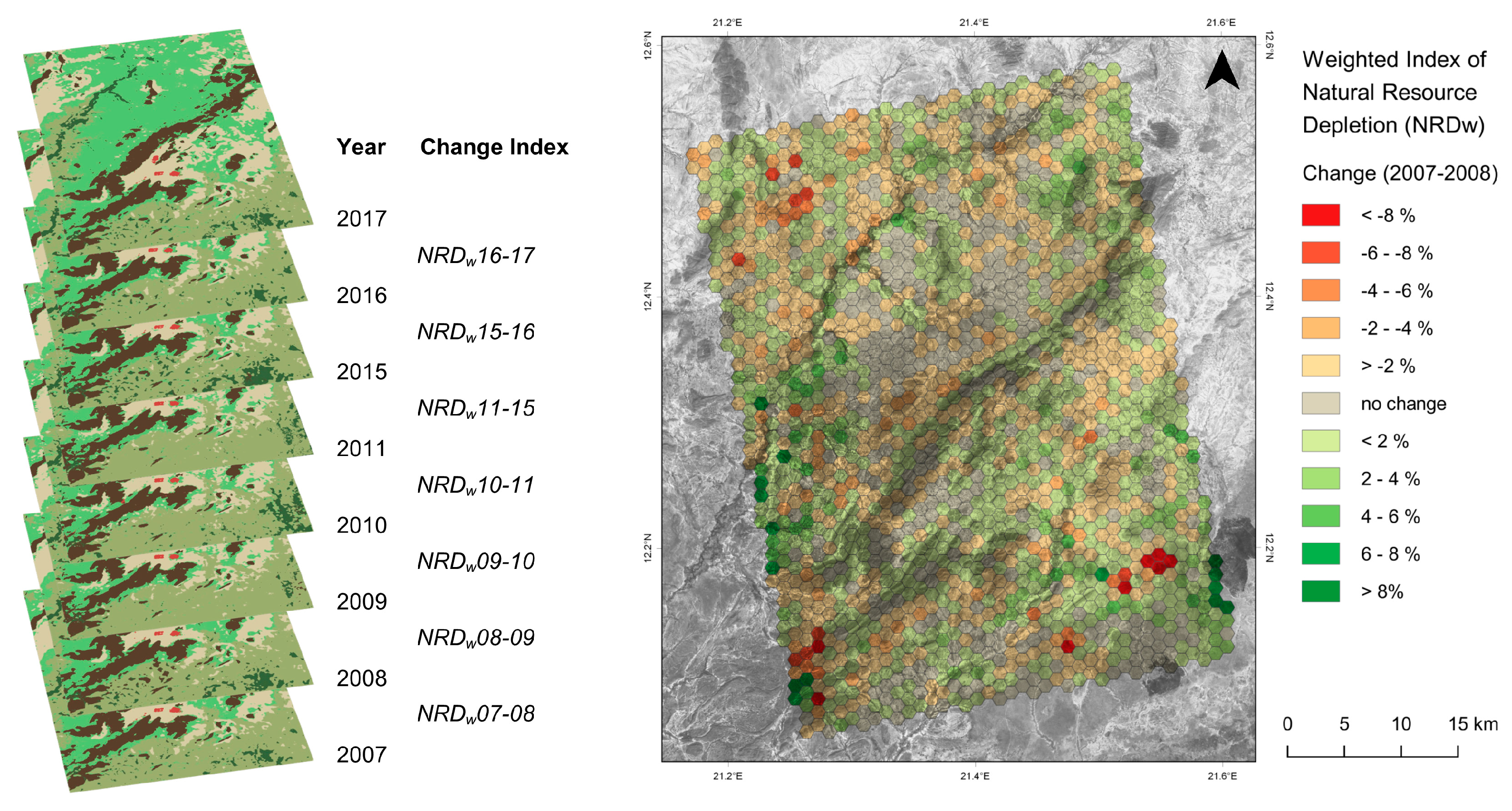
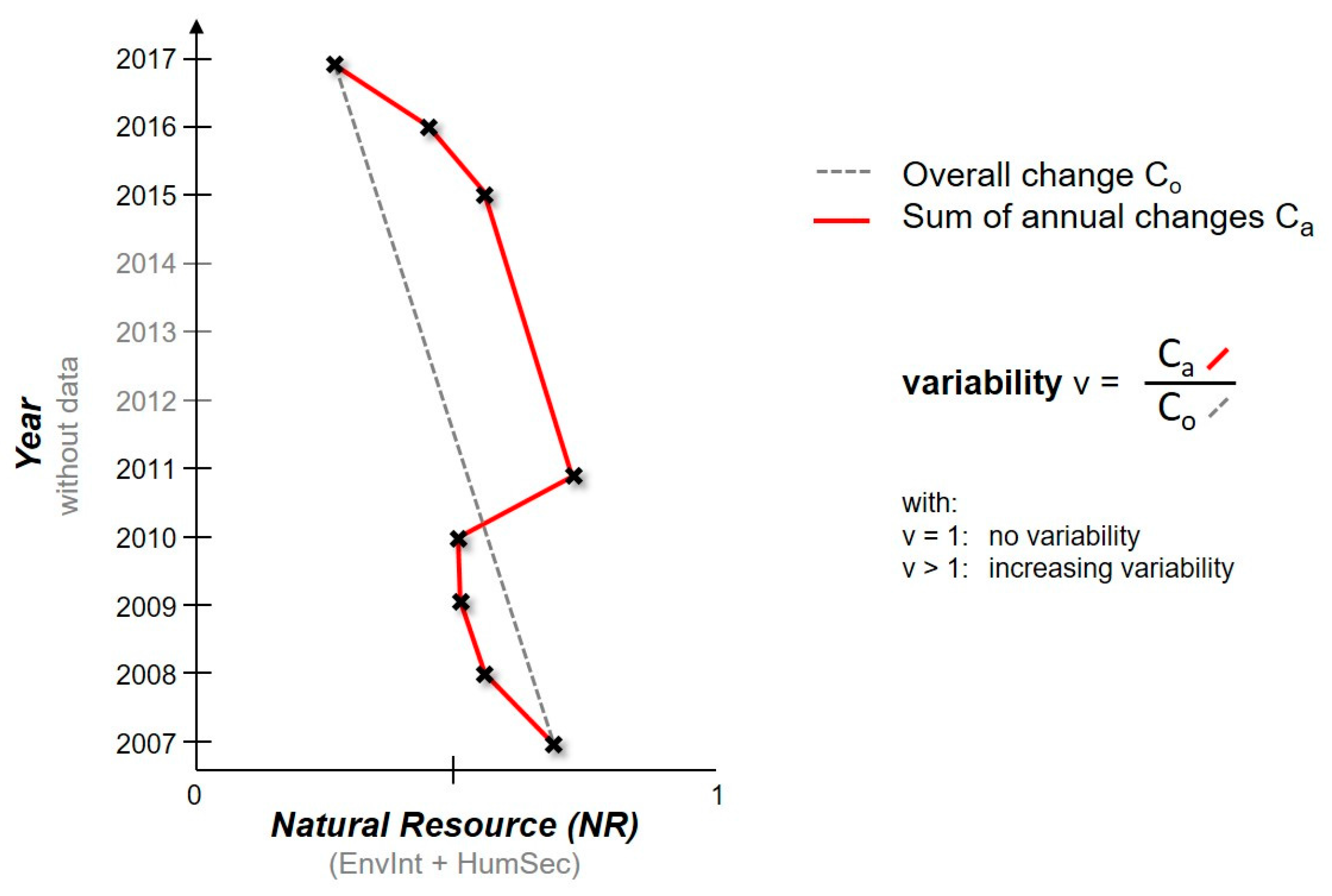
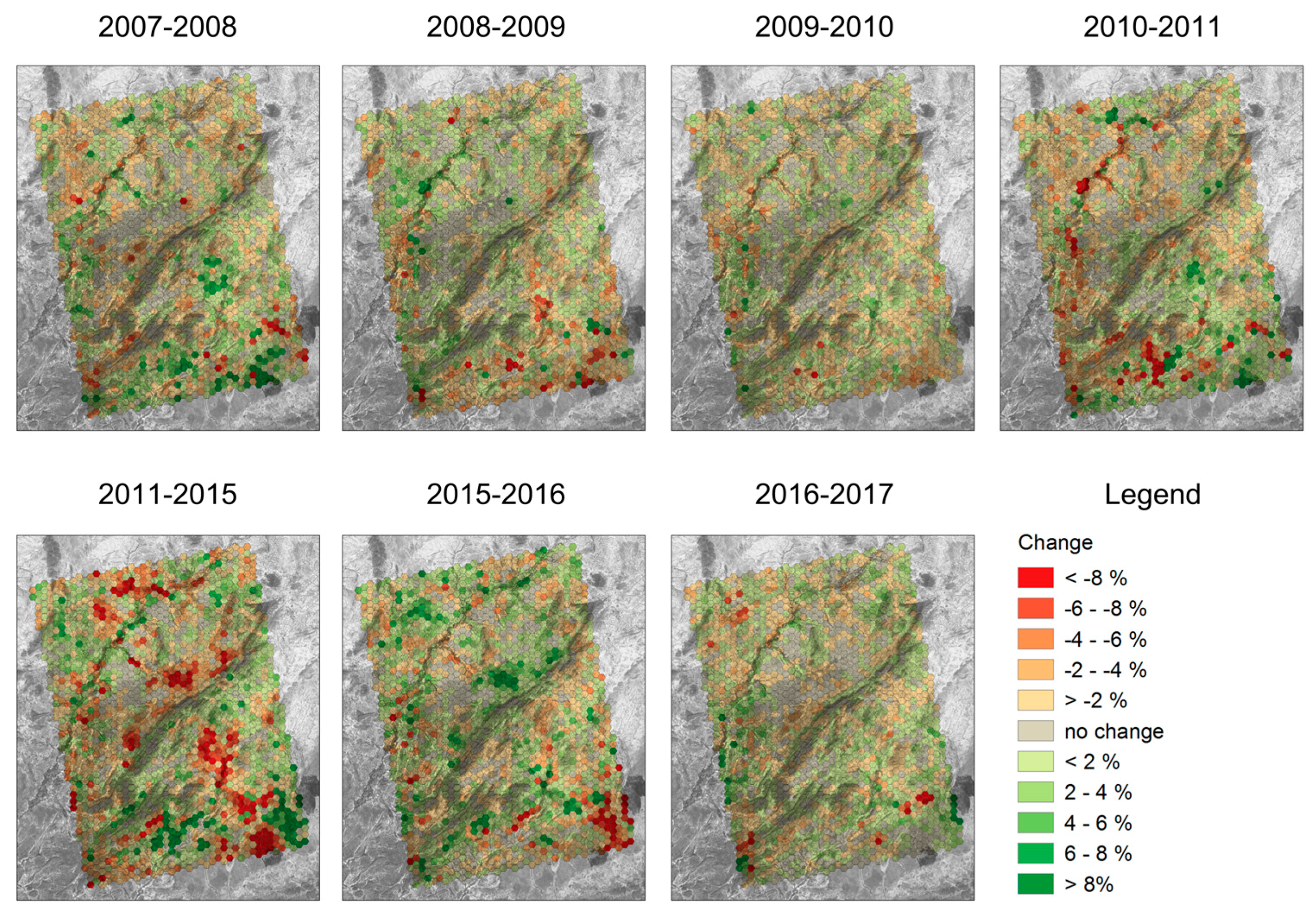
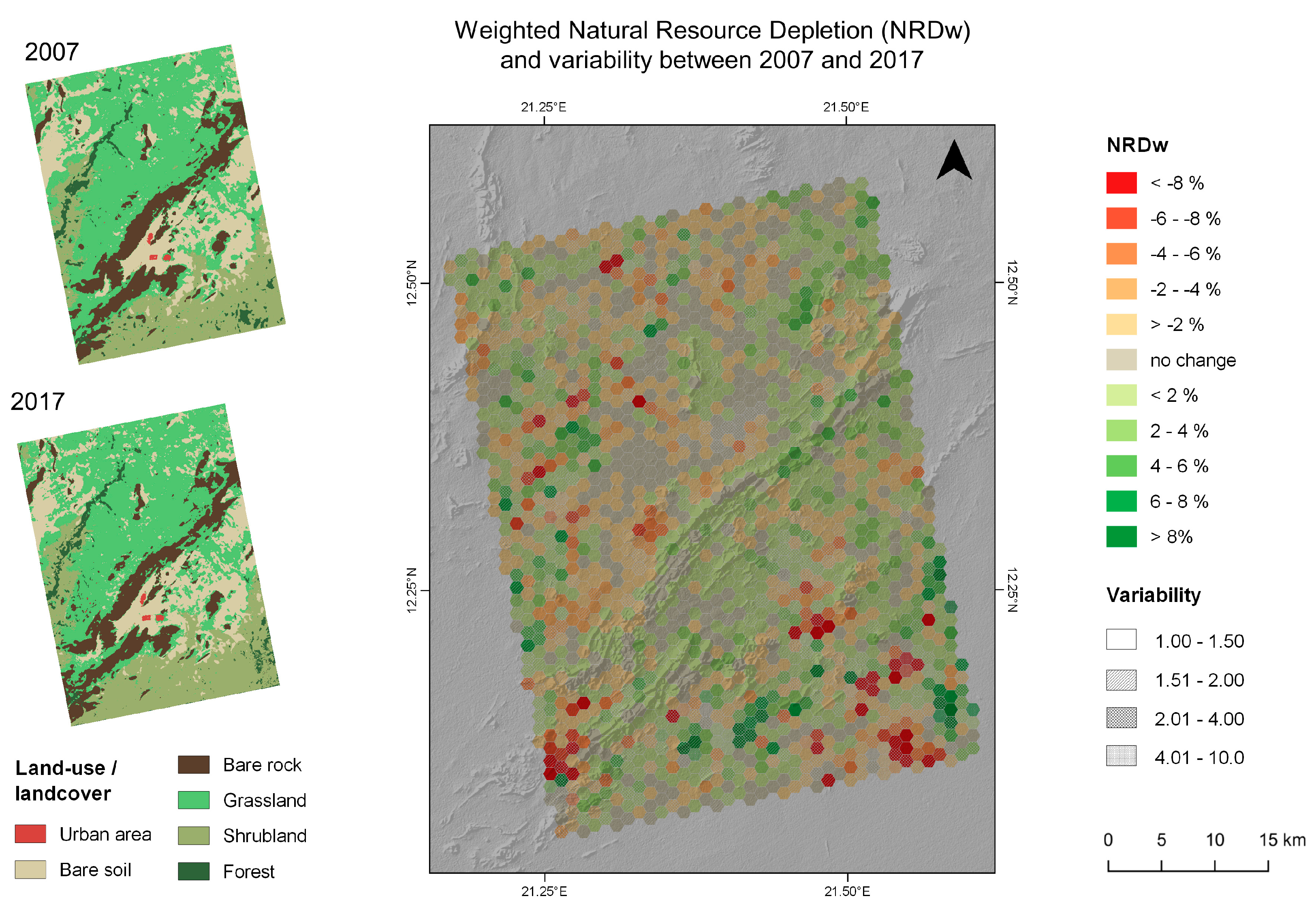
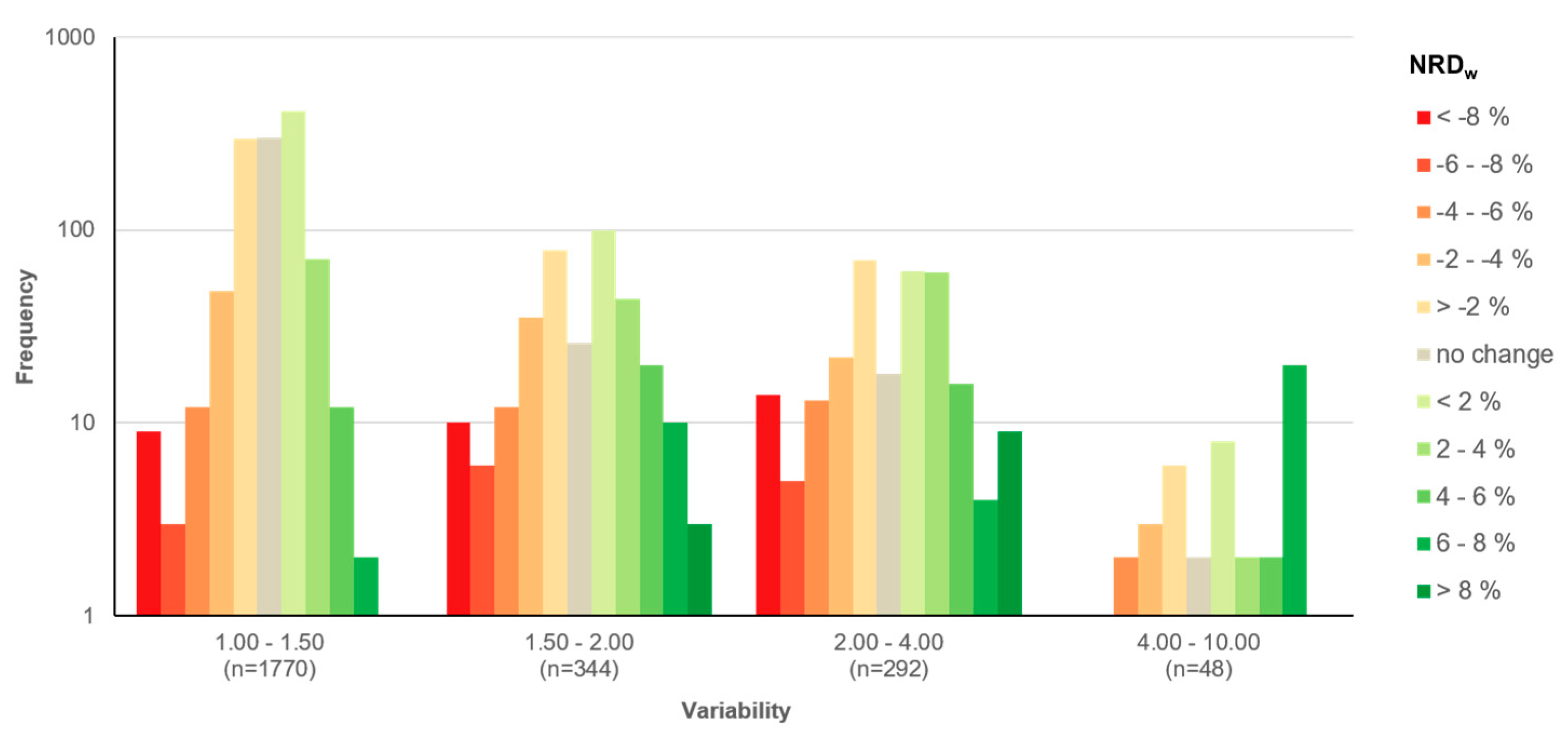
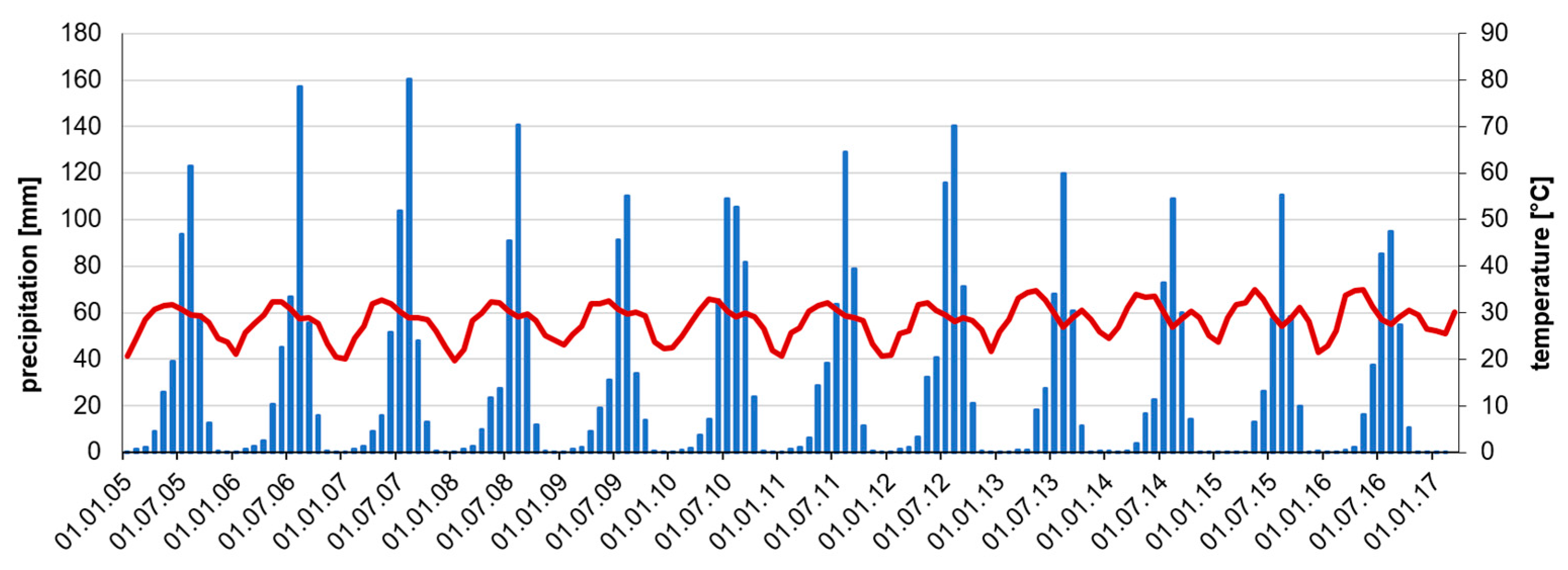
| Year/Δt | Date | Sensor | Comment |
|---|---|---|---|
| 2007/18 days | 24 December 2006 | ALOS PALSAR | SLC-off |
| 11 January 2007 | Landsat ETM+ | ||
| 2008/2 days | 27 December 2007 | ALOS PALSAR | SLC-off |
| 29 December 2007 | Landsat ETM+ | ||
| 2009/18 days | 29 December 2008 | ALOS PALSAR | SLC-off |
| 16 January 2009 | Landsat ETM+ | ||
| 2010/30 days | 2 December 2009 | Landsat ETM+ | SLC-off |
| 1 January 2010 | ALOS PALSAR | ||
| 2011/20 days | 19 February 2011 | ALOS PALSAR | SLC-off |
| 11 March 2011 | Landsat ETM+ | ||
| 2015/0 days | 23 January 2015 | ALOS-2 | |
| 23 January 2015 | Landsat OLI/TIRS | ||
| 2016/6 days | 22 January 2016 | ALOS-2 | |
| 28 January 2016 | Landsat OLI/TIRS | ||
| 2017/15 days | 2 March 2017 | ALOS-2 | |
| 15 February 2017 | Landsat OLI/TIRS |
| Class | Samples | Criterion | Source |
|---|---|---|---|
| Urban area | 161 (7.2%) | Area of the camp in 2007 | - |
| Bare soil | 390 (17.6%) | Red < 0.25 & SWIR1 > 0.35 | Drury (2001) [98] |
| Bare rock | 352 (15.9%) | SWIR1/SWIR2 > 1.5 | Drury (2001) [98] |
| Grassland | 374 (15.6%) | NDVI > 0.15 & NDVI < 0.25 | Forkuor et al. (2012) [95] |
| Shrubland | 126 (5.6%) | Red < 0.2 & NIR > 0.3 & SWIR < 0.3 | Liu et al. (2016) [99] |
| Forest | 172 (7.8%) | NDVI > 0.2 | Forkuor et al. (2012) [95] |
| Burnt areas | 0 (0%) | NBR > 0.15 | López-García & Caselles (1991) [97] |
| 2007 | 2008 | 2009 | 2010 | 2011 | 2015 | 2016 | 2017 | |
|---|---|---|---|---|---|---|---|---|
| Urban area | 89.3% | 91.3% | 90.7% | 92.0% | 89.3% | 86.0% | 90.7% | 70.53% |
| Bare soil | 92.0% | 90.7% | 92.0% | 93.3% | 92.0% | 89.3% | 86.7% | 77.88% |
| Bare rock | 96.0% | 95.3% | 96.0% | 94.0% | 96.0% | 94.0% | 93.3% | 90.91% |
| Grassland | 83.3% | 80.7% | 88.7% | 83.3% | 82.0% | 94.0% | 76.7% | 82.23% |
| Shrubland | 75.3% | 70.7% | 76.0% | 77.3% | 75.3% | 68.7% | 76.7% | 82.64% |
| Forest | 70.7% | 71.3% | 70.7% | 70.0% | 69.3% | 67.3% | 64.0% | 66.92% |
| 2007 | 2008 | 2009 | 2010 | 2011 | 2015 | 2016 | 2017 | |
|---|---|---|---|---|---|---|---|---|
| Urban area | 100.0% | 100.0% | 100.0% | 100.0% | 98.5% | 99.2% | 100.0% | 100.0% |
| Bare soil | 82.6% | 84.5% | 84.7% | 85.4% | 82.1% | 76.1% | 79.3% | 82.5% |
| Bare rock | 97.3% | 95.3% | 99.3% | 97.2% | 94.1% | 95.9% | 94.0% | 95.9% |
| Grassland | 63.1% | 61.4% | 64.6% | 62.8% | 64.7% | 57.8% | 59.3% | 57.6% |
| Shrubland | 83.7% | 84.8% | 85.7% | 82.3% | 82.5% | 80.5% | 80.5% | 78.4% |
| Forest | 89.8% | 82.3% | 90.6% | 92.9% | 89.7% | 84.2% | 93.2% | 87.3% |
| Class | EnvInt 35% | HumSec 65% | NR 100% |
|---|---|---|---|
| Urban area | 0.00 | 0.50 | 0.313 |
| Bare soil | 0.30 | 0.35 | 0.331 |
| Bare rock | 0.20 | 0.25 | 0.231 |
| Grassland | 0.50 | 0.45 | 0.469 |
| Shrubland | 0.70 | 0.75 | 0.731 |
| Forest | 0.95 | 0.90 | 0.919 |
| 2007 | 2008 | 2009 | 2010 | 2011 | 2015 | 2016 | 2017 | |
|---|---|---|---|---|---|---|---|---|
| NRmax | 91.9% | 91.5% | 90.7% | 90.1% | 91.4% | 91.7% | 89.5% | 88.6% |
| NR95% | 73.5% | 76.2% | 74.7% | 74.3% | 74.6% | 73.9% | 73.1% | 73.3% |
| NRmean | 46.9% | 47.1% | 47.0% | 47.1% | 46.9% | 46.5% | 46.8% | 47.0% |
| NRmedian | 45.7% | 45.4% | 45.9% | 45.9% | 45.8% | 44.3% | 45.6% | 45.1% |
| NR5% | 24.8% | 24.4% | 25.0% | 24.9% | 24.2% | 25.0% | 25.4% | 25.6% |
| NRmin | 23.1% | 23.1% | 23.1% | 23.1% | 23.1% | 23.1% | 23.1% | 23.1% |
| NRsum | 840.8 | 844.6 | 843.5 | 843.8 | 840.7 | 833.1 | 839.9 | 842.8 |
| NRDw mean | 0.187% | −0.037% | 0.016% | −0.175% | −0.421% | 0.379% | 0.158% | |
| NRDw net | 3.36 | −0.65 | 0.28 | −3.14 | −7.55 | 6.79 | 2.83 |
| 2007–2008 | 2008–2009 | 2009–2010 | 2010–2011 | 2011–2015 | 2015–2016 | 2016–2017 | r (NRDw) | |
|---|---|---|---|---|---|---|---|---|
| NRDw net | 3.36 | −0.66 | 0.28 | −3.14 | −7.55 | 6.80 | 2.833 | 1.00 |
| Δprec | −37.7 | −55.7 | 97.7 | −49.9 | −74.6 | 15.8 | - * | 0.47 |
| SAR Δd | 12 | 12 | 18 | 88 | 1078 ** | 8 | 12 | −0.61 |
© 2017 by the authors. Licensee MDPI, Basel, Switzerland. This article is an open access article distributed under the terms and conditions of the Creative Commons Attribution (CC BY) license (http://creativecommons.org/licenses/by/4.0/).
Share and Cite
Braun, A.; Hochschild, V. A SAR-Based Index for Landscape Changes in African Savannas. Remote Sens. 2017, 9, 359. https://doi.org/10.3390/rs9040359
Braun A, Hochschild V. A SAR-Based Index for Landscape Changes in African Savannas. Remote Sensing. 2017; 9(4):359. https://doi.org/10.3390/rs9040359
Chicago/Turabian StyleBraun, Andreas, and Volker Hochschild. 2017. "A SAR-Based Index for Landscape Changes in African Savannas" Remote Sensing 9, no. 4: 359. https://doi.org/10.3390/rs9040359






